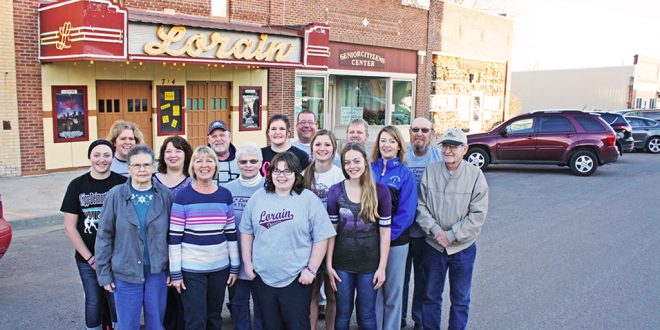Anything is possible in Armour, S.D.
“I travel a lot for work, and everyone says it could only happen in Armour,” said Cal Lout, an Armour resident and director of clinical services at Welcov Healthcare, about all of the things the town of 699 has accomplished.
The county seat of Douglas County 45 miles southwest of Mitchell supports a privately owned hospital, nonprofit-run movie theater, and a free thrift shop, just to name the highlights. Perhaps most notable is the community’s ability to overcome the “STP”—or “Same Ten People Syndrome”—that classically plagues small towns. Instead, a spirit of volunteerism permeates the air, and is breathed from one generation to the next.
“All of the things that I volunteer for are to help my kids, or to benefit their friends, because we want people to come back to a small community,” said Nicole Neugebauer, whose list of volunteer activities includes Lorain Theatre, Armour Community Exchange, and being director of the local ambulance service. “If you involve your kids, and you’re involved, you’re going to create a better atmosphere for everybody, and they’re going to want to come back.”
Neugebauer’s children are among those who regularly volunteer at the Lorain. Youth in town also spearheaded a care package drive for local deployed military personnel and a recycling program. Neugebauer, who is far from the only adult role-modeling volunteer work to their children, said doing so is an investment into the future.
“The more you volunteer,” the more likely kids are to do the same, she said, and that benefits the community in several ways. “Kids are more likely to respect things if they volunteer. When you volunteer, you’re investing yourself, and then you learn respect. … You’re learning how to help people, you’re learning how to respect other people.”
Running on volunteers’ energy

Nicole (left) and Hope Neugebauer stand inside the Armour Community Exchange, a freewill thrift shop on Main Street, Armour, S.D. The Exchange was a Horizons project over a decade ago that continues to operate with the help of several community volunteers.
“(We) projected that if we could get 10 people to volunteer consistently, and if we could get 50 people a weekend through the doors, then we could operate a movie theater,” said Lout, who has organized volunteers for the Lorain Theatre since it reopened in 1999.
When neighboring restored theaters closed due to lack of volunteer participation and/or mandatory upgrades a few years ago, the community raised more than $70,000 to keep the digital “reels” kept rolling in the Douglas County seat.
A full roster of 40 “regulars” eagerly takes tickets, pops popcorn and cleans the theater for each of the four to five showings each weekend, and another 20—some of them from out of town—volunteer occasionally.
“Not one single person is doing it to make money,” Neugebauer said, though the nonprofit rewards its dedicated high school volunteers with college scholarships whenever the bottom line allows. This year, five seniors will receive $500 each.
The desire to work at the theater starts young, and three generations of some families are represented on the volunteer rolls.
“Not only is it fun, but you get to see the movie, you get to eat popcorn. It’s that sense of giving back. The theater is all about giving back,” Lout said.
Utilizing volunteer labor helps keep ticket and concession prices down—the group advertises that a family of five can see a movie and enjoy pop and popcorn for under $25—and helps promote other businesses in town. The town’s two restaurants often are packed with moviegoers on Friday and Saturday nights.
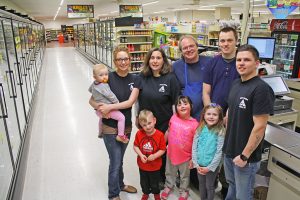
Krull’s Market has been in the Krull family since Dana Krull’s parents purchased it in 1969. Today, his own descendants regularly can be found in the store. Pictured, left to right (front row): grandson Abel Slate, daughter Molly Krull, daughter Sarah Krull, (back row), granddaughter Audrey Slate, daughter Eden Slate, wife Jennifer Krull, Dana Krull, son Seth Krull and son-in-law Dylan Slate.
Across from the Lorain on Main Street, Neugebauer runs the Armour Community Exchange, a freewill thrift shop created when the community was involved in the Horizons program over a decade ago.
The vision was for a local alternative to donating items to Goodwill or the Salvation Army, “but nobody should have to pay for it,” said Neugebauer, who suggested the project. “If you can leave a donation, great, that helps pay the electric bill,” and any extra helps purchase items that aren’t in the store for those who need them.
The Exchange was started in a single room in a Main Street storefront formerly owned by the Armour Development Corp., and now occupies three very full rooms in the same building. It is open about 13 hours a week, on average, and staffed mostly by elderly volunteers. In addition to a being a “retail” site, the Exchange also packages items to be given to orphans, missions and last year helped with tornado relief in nearby Delmont.
Often, Armour organizations join forces for the betterment of the community and its neighbors.
Last year, the Exchange received a request for snow boots for a local high school student.
“The Lorain had funds, so I went … to a store out of town and got them through the theater and donated them to the Exchange,” Lout said. “All of the organizations respect each other and help out. It’s everybody working together for the good of the town and the surrounding towns.”
Shop local, give local
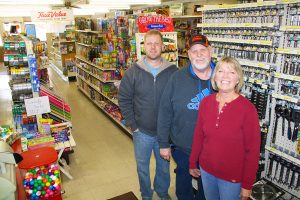
Tyler Wilson (left) works with his parents, Larry and Ronda Wilson, at Wilson True Value and is expected to eventually take over the family store.
The past two years, the Armour Community Club has promoted what Mayor Susan Hoffmann-Lout described as a “diverse Main Street” through a shop local ad campaign in The Armour Chronicle, putting names and faces to the idea that shopping in local businesses helps keep the community alive.
“This family lives here. These kids go to the school. … One of the ads features the whole family from the grocery store,” which includes two adult children who have moved their families back to Armour to help run the store, now run by the second and third generation, Hoffmann-Lout said. “People don’t really think about things like that. We’re so mobile now—we just hop in the car and go. … When you shop in town, it’s supporting all of these people.”
The Lorain purchases all of its concessions items at Krull’s Market, and many in town credited owner Dana Krull with going out of his way to ensure the success of other businesses and organizations.
But Krull said the extra time is nothing that shouldn’t be expected.
“It’s part of being a part of the community,” he said, adding that his parents taught him that helping others was just part of the business.
The grocery store recently was remodeled and now carries a variety of local and organic foods, due to the requests of customers.
“It’s about what the customer wants,” he said. “If it can help somebody’s health styles be a little better, surely we will give it a whirl.”
Adaptation is prevalent among Armour businesses.
“Armour has a diverse Main Street. … A lot of businesses have adapted to wear more than one hat. The hardware store isn’t just a hardware store. They do other services, (and) they have other products that you wouldn’t think of at a hardware store,” Hoffmann-Lout said.
Larry and Ronda Wilson have owned Wilson True Value on Main Street since 1989. In the early days, the business was a hardware store that offered some houseware items. Today, the Wilsons also sell small appliances, toys, lawn and garden and giftware, as well as small engine sales and repair.
“We just have to keep looking for that certain niche, or that thing that people are looking for,” said Ronda Wilson. “It seems to be getting harder, with online shopping with free shipping.”
Some of their customers are starting to use True Value’s online shopping feature.
“Sometimes, it seems that’s all that people want to do—they don’t want to go out and shop anymore. They just want to sit at home and do their shopping, and then pick it up,” she said, which has hurt the local store in some ways, because many shoppers—especially the younger ones—leave with their online purchases without really looking around the store.
But Armour, like many communities set along highways, boasts two “business districts.”
Downtown is predominantly filled with banks, diners and retail shops, while the 281 corridor is mostly lined with ag, auto and medical facilities. Representatives from businesses in both areas of town—and others—are a part of Armour’s active Community Club.
“We all try to work together,” Hoffmann-Lout said.
Certain community events—such as Christmas in Armour—are held on Main Street each year, while others—such as the Prairie Festival each August—are held at the edge of town, to help bring attention to as many businesses as possible.
Local medical service

Douglas County Memorial Hospital’s success as a minority independent health care organization lies within its board of directors’ foresight and investments, according to Administrator Heath Brouwer, pictured with (back row, from left) Physician Assistant Amber Wolter, Registered Nurse Pam Blume, (front row) Registered Nurse Annie Rolston and Certified Nurse Aide Jody Wright.
One of the first businesses visible upon entering Armour from the north on Highway 281 is Douglas County Memorial Hospital, one of the community’s largest employers, with 100 people on the payroll.
“For Douglas County, it’s a big deal,” said hospital administrator Heath Brouwer. “We think that local control—community control—is the best for us,” but services from both “systems”—Avera and Sanford—help the hospital offer services that otherwise would be difficult to provide in a small community. “If we do have a trauma, we have access to an ER physician over at Sanford. We just hit a button, they pop up on a screen, and then they can help us run a trauma or a code.”
With two general practitioners and four physician assistants on staff, it’s helpful to have specialists available at the click of a button.
“They are asked to see small infants to the elderly, to deal with trauma, they’re asked to do a lot. It’s just another set of eyes, to help them do their job,” Brouwer said. “They have to be a jack of all trades to work here. …We try to keep as many people here as we can,” whether that’s through traditional appointments with local providers or specialists who visit either weekly or monthly, mobile diagnostic services, or telehealth. “We offer quite a bit.”
The local hospital, run by a six-member board of directors, also owns clinics in Armour, Corsica and Stickney, pharmacies in Armour and Corsica, and an assisted living in Armour. Until the beginning of this year, 25-35 babies were born at the local hospital. That service was discontinued when the hospital’s full-time general surgeon retired, but a Mitchell obstetrician sees Armour-area patients at Prairie Health Clinic for the earlier months of pregnancy, before moving them to his Mitchell patient load prior to deliver.
“He’s very good about getting those babies and their babies back here to see our providers” after delivery, Brouwer said.
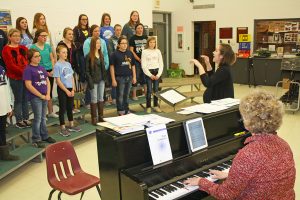
The Armour (S.D.) School District is known for its strong music program. Roughly 80 percent of the District’s 50 high school students are involved in band, choir or both. Above, K-12 Music Teacher Whitney Wilson directs the girls’ choir. “I try to pick music that I know they will like, but yet that we’ll learn something from,” said Wilson, who insists the music program has a lot to do with student success. “It’s a good break in their day. It gets their creative juices flowing” and helps with math and science concepts. “A lot of times, the kids are like, ‘Why are we learning math?’” The school’s band director, Heather Harnisch, agreed, saying, “I teach fractions like nobody’s business, trying to teach them time signatures.”
“All of our nurses are still trained, we’ve got the same docs who would do them anyway. … If some way or another we find a way to have someone do them, we’ll get back into it,” he said, but the liability is too high without cesesarean-trained physicians. “There are family docs who do (c-sections). Ours just don’t, so if we look for that (and) we can find a couple who can potentially do that,” babies may be born in Armour again.
While the odds seem to be against privately owned health care centers, Douglas County Memorial Hospital is standing strong. A $4.5 million project in 2014 upgraded 9,000 square-feet of the 1957 facility and added another 9,000 square-feet. The facility now offers larger, private rooms with private bathrooms, and chemotherapy services soon will be available.
“Looking to the future, staying ahead of the game, spending our money wisely, we’ve tried to do our best and answer to the needs of our patients,” Brouwer said.

Armour, S.D., Superintendent Burnell Glanzer, who retires after 41 years working in the district this spring, says the key to keeping a building in good condition long-term is “the people you put in it.” The District’s buildings range from 40 to almost 100 years old. “Make do with what you have, and keep it in good shape,” he said of the building kept in pristine shape for the District’s 170 students. That’s kind of the mantra around here, and I think the people in town expect no less from us, so that’s what we try to do.”
And the facility provides more than health-related peace of mind to local residents.
“When you come here, you’re being treated by people that you know. We know a majority of our patients here, and you know we’re going to treat them better probably that if they would if they had to drive 100 miles or 200 miles to receive the same type of care,” Brouwer said. “It also provides a lot of employment, jobs, keeps the housing economy good, just keeps the economy in general in Douglas County better when you have healthcare that is paying workers. I think it’s very vital to the community.”
A news hub
Armour may not always have a lot of its own news, but a lot of news starts its journey to readers there through Rocket Printing, where 26 area publications are printed each week.
“Each town, we find, is a little different,” said Dean Heller, Rocket general manager. “Some towns don’t print the bad news—they just print the good news. Other towns are trying to assimilate like a big city would and put good stories and bad stories and whatever they think at the time is going to be a big story. Doing 22 newspapers a week, you see quite a variance in what each town thinks is important.”
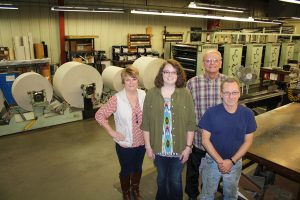
A lot of area news originates—at least in its tangible form—on Main Street in Armour, S.D. Twenty-six publications, including 22 area weekly newspapers, are printed at Rocket Printing. Pictured are Rocket officer manager Julie Hinckley, office assistant Juenelle Dyk, general manager Dean Heller (pictured at rear) and pressman Butch Weitzman.
Rocket Printing started in 1971 in Chamberlain, but was moved to Armour in 1971 to be more centrally located amid the 22 weekly newspapers that print there. Total print counts for all of the publications have dipped 21 percent—from 65,210 in 2008 to 51,230 in 2014—but local newspapers still are relevant.
“Especially in the small towns, (older folks) like to go to the stores and have something in their hands that they can take home. … They look forward to the grocery inserts that come out, and finding out the news they didn’t know at coffee. I think small town newspapers are going to be around for a long time, the quantities might continue to decrease, but we’re still going to be here,” Heller said. “As more papers get on the internet, some of the papers aren’t doing as much in print, so finding new customers is difficult, but keeping the existing ones happy has been the main goal.”
Recently, the company, which employs four people full-time and eight people part-time—mostly Monday through Wednesday noon, when the publications are printed—upgraded equipment, so the papers can submit their pages electronically each week, allowing the paper to be printed within an hour of being sent over.
Previously, “they would come in and they would be asked to opaque their own negatives, get back there and make their own plates from time to time, and then go prepare their stuff for labeling.
Now they just get in the back door, get their bags ready, and they’re out in an hour-and-a-half or so,” Heller said. “It gives them much better quality, and should give them a lot better product to sell to their advertisers.”
 Dakotafire Get your spark here.
Dakotafire Get your spark here.


